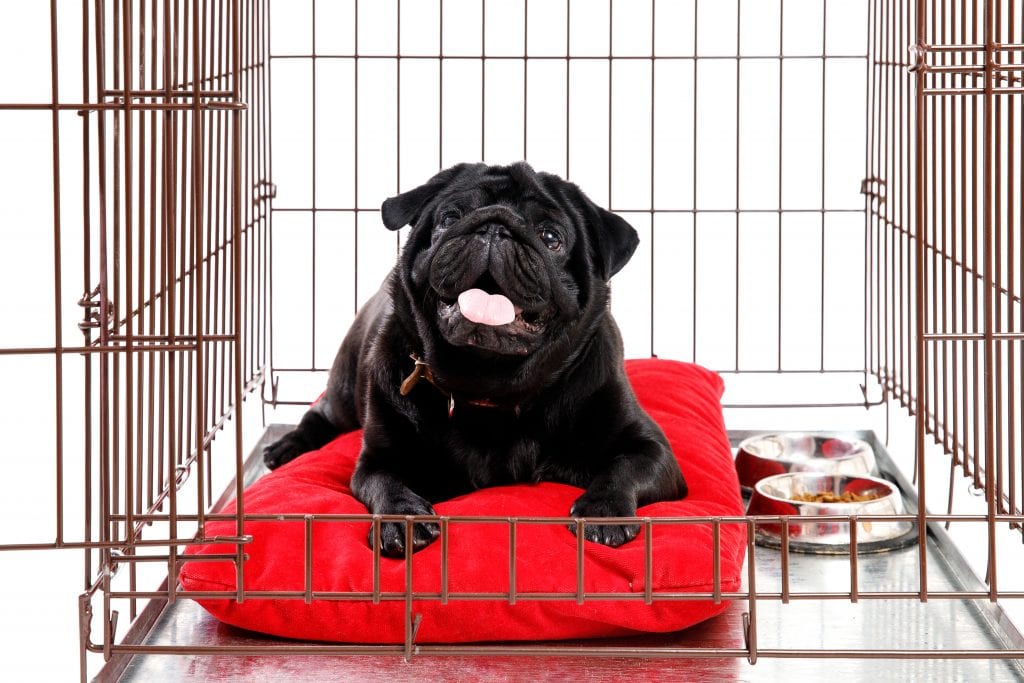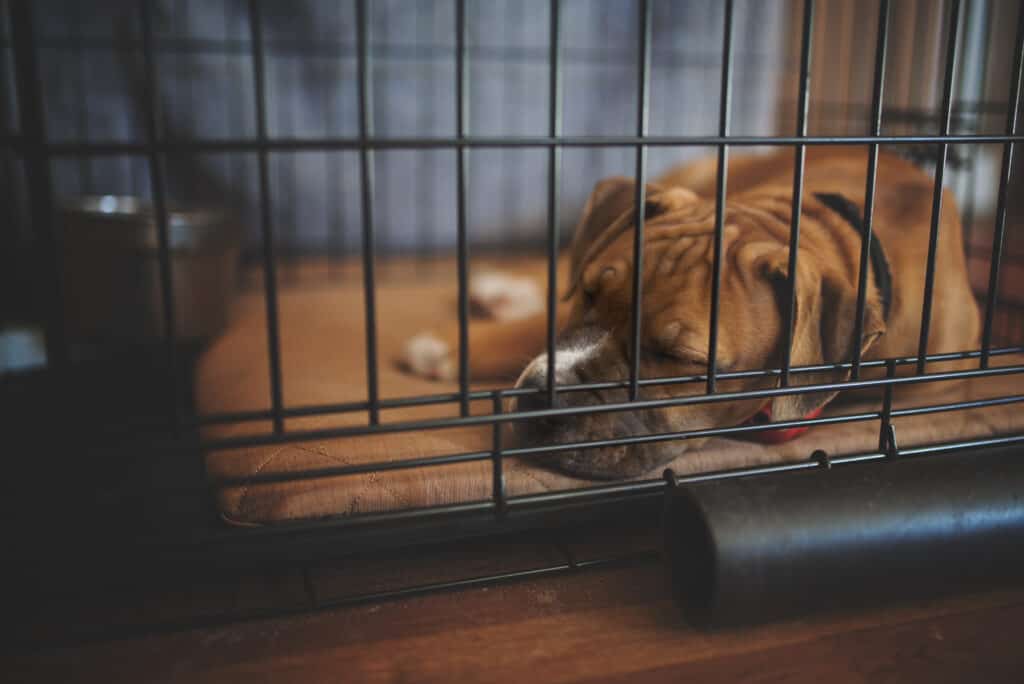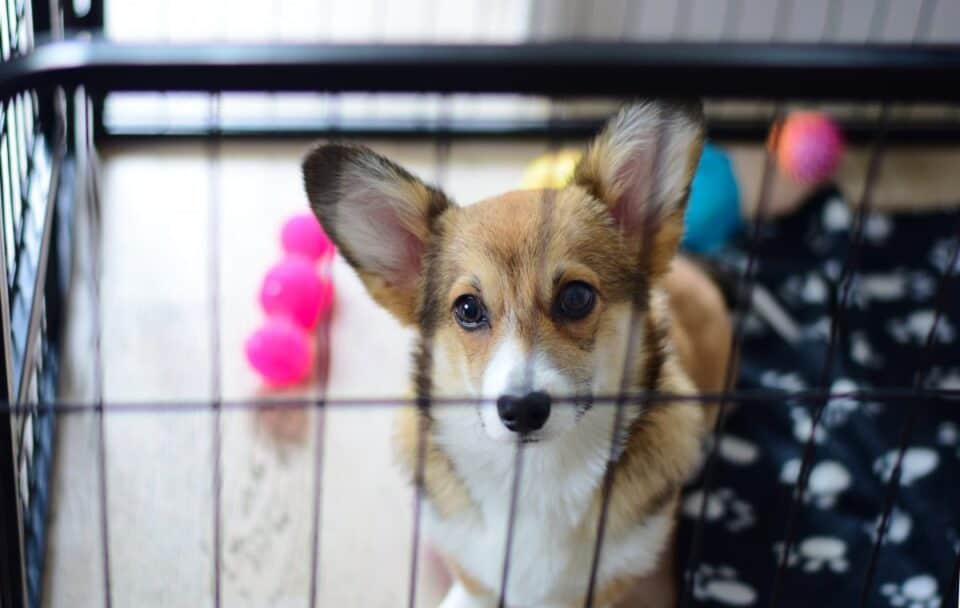All products and services on Project PAWS are independently selected by our editors, contributors, and veterinary experts. This post contains affiliate links. As an Amazon Associate I earn from qualifying purchases.To learn more, view my disclosure policy.
Last Updated on October 29, 2020 by Aimee
Crate Training 101: The crate is an indoor dog house – large enough for a dog to stand up, lie down, and turn around in – made of plastic, wire fabric or heavy duty aluminum. A crate should be like a little cozy den, a safe place where your dog knows it is safe and you know they are safe. During potty training and puppy hood the crate is the primary place your dog should be if you are unable to have your focus on your dog.
The crate should be placed in a commonly used area of the household, such as a living room or kitchen. For young puppies, the crate can be placed in a bedroom to help with overnight house-training issues. You can travel with the crate so your dog always has their safe place to help bring them comfort in a new environment. The crate should be used as a management tool and a safe place for your dog to be away from the fuss of a busy environment. It should not be used as punishment.
Crates mean treats
Leave the crate door wide open and make sure your dog has access to the room where you’ve set up the crate. Every so often, when your dog isn’t looking, toss a few treats around and into the crate so they can discover them on their own. Use something that your dog will love, like small pieces of tasty dog treat, cheese or freeze-dried liver. You can also leave an exciting new toy, a delicious chew bone or a stuffed toy inside the crate. Periodically leave special treats in your dog’s crate throughout the evening, and continue to do so every day or so for the next few weeks. If your dog sometimes finds surprise goodies in their crate, they’ll start to love it, and probably go just to see if the “Treat Fairy” has come.

Room Service
Feed your dog in their crate with the door open. If your pup afraid going all the way in, start by placing the food dish just outside the crate and slowly moving into the crate over a few meal times. Once your dog will go all the way into the crate to eat close the door briefly, when your pup finishes with the meal open the door.
Build the crate into a daily command by helping your dog learn to “go to the crate”.
Step One: Follow the Treat
It is best to initiate this step early in the day.
- Show your dog one of the treats and toss it in the crate while saying “kennel”. After they goes inside to eat it, praise him enthusiastically and feed him another treat while he’s still inside.
- Release your dog from the crate with another cue like “Release” or “Let’s go.” For right now, don’t reward your dog for coming out of the crate; he needs to learn all good things happen while he’s inside the crate.
- Repeat the steps above 10 times.
- Take a short break (just a few minutes), and then do another set of 10 repetitions. After your second set, end the training session.
Step Two: Earn the Treat
Later in the morning after they practiced following a treat into the crate in step one, you’ll be asking them to go in before rewarding with the treat.
To warm up, do a couple repetitions of step one to re-introduce your dog to the training and get your groove back. Throw a treat in the kennel a couple times and have them go into the crate to eat it.
- Point to the crate instead of throwing a treat into it and say the command “kennel” (When you point, it might help to move your arm like you did when tossing a treat into the crate. The familiar motion can remind your dog what he’s supposed to do.)
- When your dog goes in, praise and immediately give a couple of treats while they are still in the crate. Release your dog from the crate.
- Repeat the steps above 10 times.
Step Three: Close the crate door
To warm up, do a couple repetitions just like you did before in step two. Say “kennel,” point to the crate, reward your dog with a treat when they goes in and then cue them to come out.
Now you’ll try closing the crate door for a very short amount of time and time it. Start with 5 seconds.
- Give your cue “kennel” and point to the crate.
- When your dog goes in the crate, praise them and immediately give a treat.
- Then gently close the crate door. (You don’t have to latch it yet.)
- Feed your dog two or three treats through the closed crate door and continue to praise them while he’s in the crate.
- Say “release” and open the crate door to let your dog out. (If your dog seems stressed or panicked with the door briefly closed, break down this exercise into two phases: in the first phase, just close the door halfway, give a treat and release your dog; in the second phase, close the door all the way.)
- Repeat steps above 10 times if the dog is enjoying the game.

How long can I crate my dog?
At night when dogs sleep, their body systems and elimination slow down. This explains why they can go all night without eliminating once they’re old enough to have sufficient bladder and bowel control. During the day, neither puppies nor adult dogs should be crated for more than six hours at a time. Always make sure you take them out to eliminate before putting them into the crate no matter their age.
Maximum time in crate 30–60 minutes
Dog age: 2 -4 months = 1–3 hours, 4 – 7 months = 3 – 4 hours, 7 months and up = 5 hours
Step Four: Add duration
- After your dog is in the crate with the door closed, sit right next to the crate.
- Drop treats into the crate every 30 seconds or so.
- Then, begin lengthening the time between treats, working up to one minute and then to two minutes.
- For the next session, move from 30 seconds to 60 seconds quickly.
- Get up and depart from the crate in different directions returning at regular intervals to reward in the crate.
If your pup whines and barks in the crate make sure to let them out before they become unhappy.
It’s crucial to break down the length of time in a crate to avoid such displays. Yelling at your dog to be quiet is not appropriate. Ignore the whining and reward the quiet.
If you have a cat, check out our post on Litter box Training!

